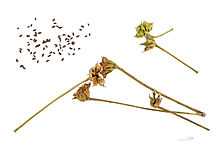Caltha palustris
| Caltha palustris | |
|---|---|
 | |
| Scientific classification | |
| Kingdom: | Plantae |
| (unranked): | Angiosperms |
| (unranked): | Eudicots |
| Order: | Ranunculales |
| Family: | Ranunculaceae |
| Genus: | Caltha |
| Species: | C. palustris |
| Binomial name | |
| Caltha palustris L. | |
| Synonyms | |
|
Trollius paluster Krause | |

Caltha palustris (kingcup, marsh marigold)[1] is a perennial herbaceous plant of the family Ranunculaceae, native to marshes, fens, ditches and wet woodland in temperate regions of the Northern Hemisphere.
It becomes most luxuriant in partial shade, but is rare on peat. In the United Kingdom, it is probably one of the most ancient native plants, surviving the glaciations and flourishing after the last retreat of the ice, in a landscape inundated with glacial meltwaters.
Height is up to 80 centimetres (31 in) tall. The leaves are rounded to kidney-shaped, 3–20 centimetres (1.2–7.9 in) across, with a bluntly serrated margin and a thick, waxy texture. Stems are hollow.
The flowers are yellow, 2–5 cm (1–2 in) diameter, with 4-9 (mostly 5) petal-like sepals and many yellow stamens; they appear in early spring to late summer. The flowers are visited by a great variety of insects for pollen and for the nectar secreted from small depressions, one on each side of each carpel.
Carpels form into green sac-like follicles to 1 cm long, each opening to release several seeds.
Caltha palustris is a highly polymorphic species, showing continuous and independent variation in many features. Forms in the UK may be divided into two subspecies: Caltha palustris subsp. palustris, and Caltha palustris subsp. minor.
It is sometimes considered a weed in clay-like garden soils, where every piece of its root will survive and spread. In warm free-draining soils, it simply dies away.
As is the case with many members of the family Ranunculaceae, all parts of the plant are poisonous and can be irritant. Skin rashes and dermatitis have been reported from excessive handling of the plant.
Other names and etymology

In the UK, Caltha palustris is known by a variety of common names, varying by geographical region. These include marsh marigold and kingcup (the two most frequently used common names), mayflower, May blobs, mollyblobs, pollyblobs, horse blob, water blobs, water bubbles, gollins. Balfae (in Caithness) and the publican. The common name of marigold refers to its use in medieval churches at Easter as a tribute to the Virgin Mary, as in Mary gold.
The specific name palustris, Latin for "of the marsh", indicates its common habitat.
Richard Mabey, in Flora Britannica, describes Caltha palustris thus:
"Marsh-marigolds are in decline as agricultural land continues to be drained, but they are still the most three-dimensional of plants, their fleshy leaves and shiny petals impervious to wind and snow, and standing in sharp relief against the tousled brown of frostbitten grasses. Most of the plant's surviving local names - water-blobs, molly-blobs, water-bubbles - reflect this solidity, especially the splendid, rotund 'the publican' from Lancashire."

In North America Caltha palustris is sometimes known as cowslip. However, cowslip more often refers to Primula veris, the original plant to go by that name.[2][3][4] Both are herbaceous plants with yellow flowers, but Primula veris is much smaller.
Caltha palustris is a plant commonly mentioned in literature, including Shakespeare:
- Winking Marybuds begin
- To open their golden eyes (Cymbeline, ii. 3).
Kingcup Cottage by Racey Helps is a children's book which features the plant.
In Latvia Caltha palustris is also known as Gundega which is also used as a girls name which symbolizes fire. The word Gundega is made from 2 words - uguns (fire) and dega (burned). This refers to the burning reaction that some people experience from contact with Caltha sap.
Subspecies, varieties and cultivars


The 2006-2007 edition of the Royal Horticultural Society Plant Finder, a British publication which lists over 70,000 plants available in nurseries in the United Kingdom, lists the following:
- Caltha palustris[5]
- Caltha palustris var. alba
- Caltha palustris var. barthei
- Caltha palustris var. himalensis
- Caltha palustris var. palustris
- Caltha palustris var. palustris 'Plena' (double flowered)
- Caltha palustris subsp. polypetala
- Caltha palustris var. radicans
- Caltha palustris 'Flore Pleno' (a double-flowered cultivar, awarded the RHS's Award of Garden Merit)
- Caltha palustris 'Semiplena' (double flowered)
- Caltha palustris Trotter's form
- Caltha palustris 'Yellow Giant'
- Caltha palustris 'Marilyn'
- Caltha palustris 'Multiplex' (double flowered)
Environmental conservation
It is a component of Purple moor grass and rush pastures - a type of Biodiversity Action Plan habitat in the UK. It occurs on poorly drained neutral and acidic soils of the lowlands and upland fringe.
Notes
- ↑ BS 7370-5 Recommendations for maintenance of water areas
- ↑ "cowslip". Webster's 1828 Dictionary.
- ↑ "cowslip". The American Heritage Dictionary of the English Language, Fourth Edition. 2000.
- ↑ "cowslip". Merriam-Webster Online Dictionary.
- ↑ "RHS Plant Selector - Caltha palustris". Retrieved 20 June 2013.
References
- Clapham, A. R., Tutin, T. G., and Warburg, E. F., 1962, Flora of the British Isles Cambridge University Press
- Lord, Tony (ed), 2006, RHS Plant Finder 2006-2007 London: RHS/Dorling Kindersley ISBN 1-4053-1455-9
- Mabey, Richard, 1997, Flora Britannica London: Chatto and Windus
- Rose, Francis, 2006, The Wild Flower Key (edition revised and expanded by Clare O'Reilly) London: Frederick Warne ISBN 0-7232-5175-4
- Flora of China: Caltha palustris
- Flora Europaea: Caltha palustris
- Flora of North America: Caltha palustris
- Germplasm Resources Information Network: Caltha palustris
- Pink, A. (2004). Gardening for the Million. Project Gutenberg Literary Archive Foundation.
 Rines, George Edwin, ed. (1920). "Cowslip". Encyclopedia Americana.
Rines, George Edwin, ed. (1920). "Cowslip". Encyclopedia Americana.
External links
| Wikimedia Commons has media related to Caltha palustris. |